Menu
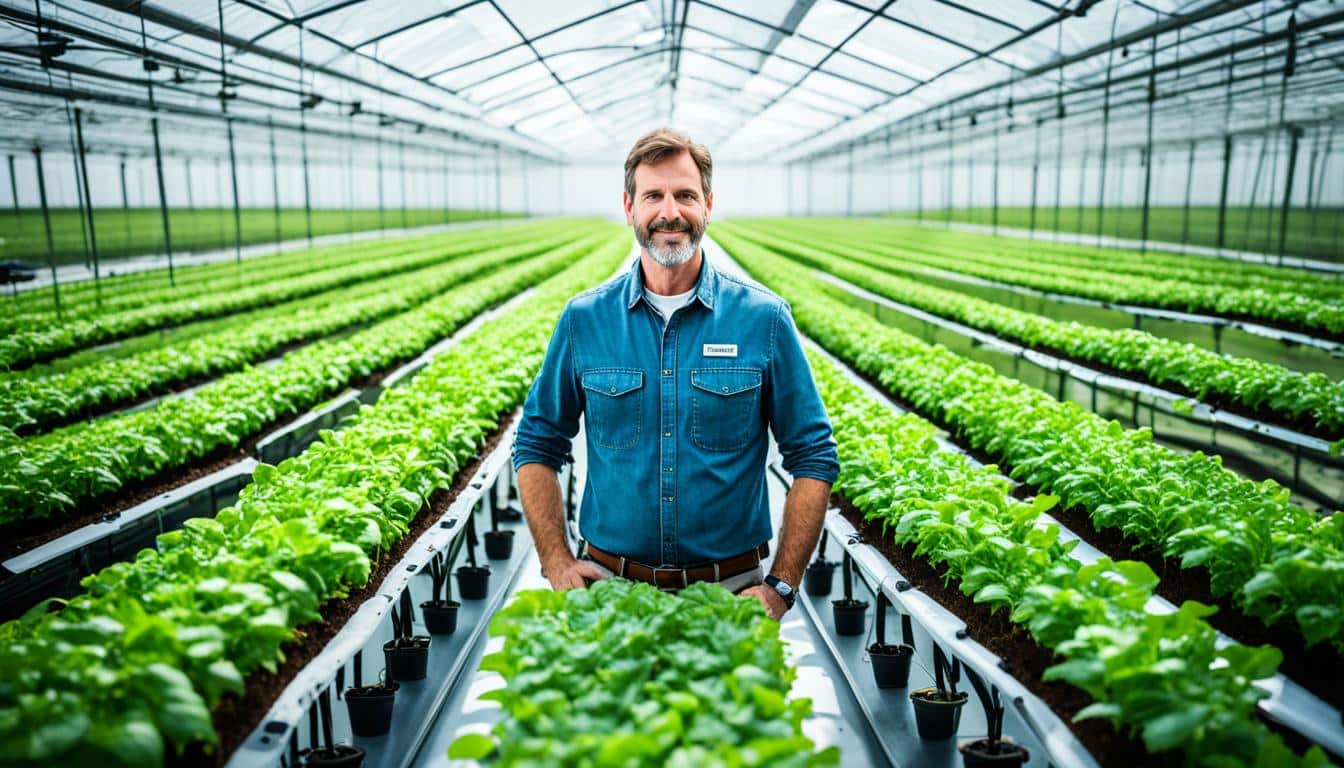
Climate change might lower crop yields by 6% to 10% by 2050. With the world’s population set to reach 9 billion, farming must boost food production 70%. This shows the critical need for new farming solutions, with data-driven farming leading the way.
Data-driven farming uses algorithms, AI, and machine learning. It helps farmers understand and use key data. This leads to smart use of resources like water and healthy soil, increasing sustainability. With more advances, data-driven farming’s impact looks very promising.
Modern agriculture faces many hurdles. The key issues include climate change, shortage of resources, and pest control. It’s vital to also focus on saving water and maintaining soil health. Doing so helps keep farming productive and the environment safe.
Climate change is really hurting farming. It’s estimated that by 2050, our crops could produce 6-10% less. This is tough because the world’s population is growing fast; we’ll need to produce 70% more food. Farming and deforestation create a lot of harmful gases. This worsens the climate problems. Also, we can only use 12% of the land for farming, making it harder to find resources.
Dealing with pests is a big challenge. They damage crops worldwide every year. Finding effective ways to fight them off is key to protecting our food. Using the newest technologies in farming, like precision farming, can help a lot. Predicted to reach $43.4 billion by 2025, these technologies show a lot of promise. New steps in blockchain technology also help fight food fraud. They cut down on recalls and make supply chains more efficient. This all adds up to better protection for crops.
Farming uses up a lot of water – in fact, it uses 70% of the world’s fresh water. To save water, techniques such as vertical farming are being explored. This method can use much less water than standard farming. Another big problem is soil erosion, leading to lost money for farmers every year. We need to find ways to stop the erosion. Protecting the soil is crucial for the future of farming.
| Challenge | Impact | Innovative Solutions |
|---|---|---|
| Climate Change | 6-10% yield reduction by 2050 | Precision agriculture, greenhouse gas reduction strategies |
| Resource Depletion | Only 12% of land usable | Vertical farming, blockchain technology |
| Pest Management | Substantial annual crop losses | Advanced pest control technologies, blockchain for food safety |
| Water Scarcity | 70% of freshwater used | Conservation agriculture, vertical farming |
| Soil Health | $100 million annual erosion losses | Soil management techniques, precision agriculture |
Modern agriculture needs to change. It must use new, smart methods to keep producing food sustainably for the future.
Farming has changed a lot over the years, especially with the use of data. In 2018, the Agriculture Data Act showed how important data is in farming. With so much data available, farms can now improve how they work.
The use of historical agricultural statistics goes way back. George Washington and others used numbers to make farming better. Now, thanks to places like Texas A&M University, we’re using high-tech stuff to farm smart.
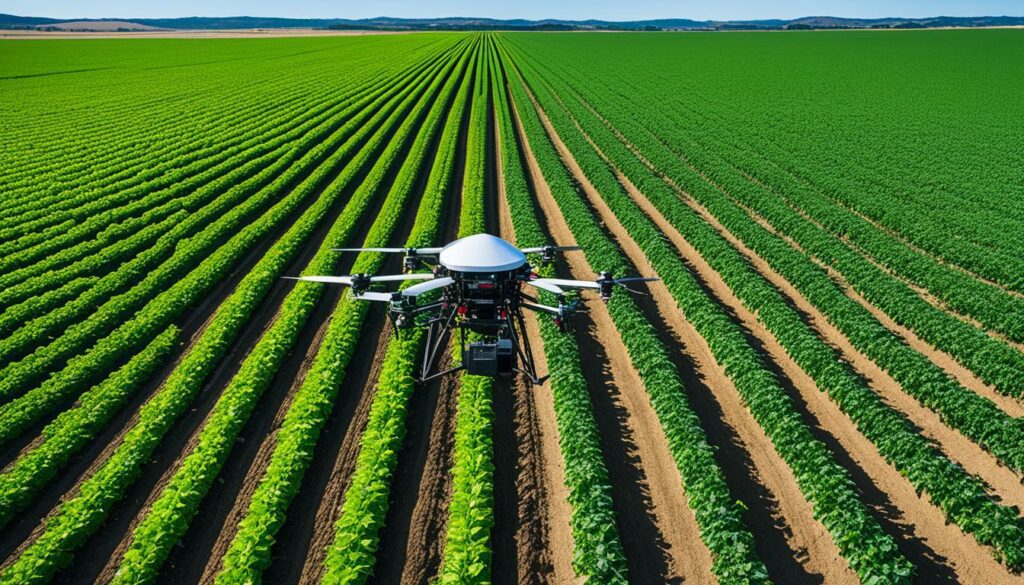
Soil health data is key to today’s farming. Using data science, we can find out a lot about the soil. This helps farmers use fertiliser better and waste less. Tools like cloud tech make looking after the soil even easier and more detailed.
Thanks to big data, farmers can now make their fields more productive. With smart soil maps and data analysis, they predict how well their crops will do. AI and machine learning also help make quick decisions, boosting both growth and eco-friendliness.
The way we use data in farming is totally changing how we work. It helps farmers do better and be more sustainable.
Data science boosts agricultural productivity significantly. It provides insights from big data, improving farming methods. When farmers use weather, soil, and satellite data, they can make their efforts more efficient. This not only reduces waste but also boosts crop yields.
One key benefit is predicting crop yields and water needs. Machine learning is crucial here. It helps with decisions such as how much to water crops. This makes farming more efficient, leading to better results.
The Agriculture Data Act of 2018 highlights the value of using data in farming. It encourages studies in areas like supply chains and nutrition. Thanks to this, farmers can find the best crops for their land, improving their harvests.
Data also helps in managing livestock. By spotting health issues early, farmers prevent diseases from spreading. They use advanced analytics to do this. It also helps them understand market trends better.
Technologies like remote sensing and IoT devices are changing farming. They offer real-time information about crops. For soil, data science shows the best way to use fertilisers. This reduces waste and boosts efficiency.
| Benefit | Description |
|---|---|
| Climate Resilience | Leveraging historical weather data for accurate predictions. |
| Resource Efficiency | Precise water and fertiliser application leading to reduced waste. |
| Disease and Pest Control | Early identification and prevention of disease and pest outbreaks. |
| Enhanced Yield Prediction | Better decision-making through machine learning models. |
| Improved Supply Chain Logistics | Analysing real-time data for better transportation and storage. |
Data science is transforming agriculture. By using data to grow crops smarter, farmers can achieve higher yields and better manage pests. They also save resources. The future of farming is in these data-driven techniques. They continue to offer great precision in farming.
Today, smart farming techniques are vital. They boost production and sustainability. By learning about modern tools and methods, we see how much agriculture has evolved.
Agricultural satellite imagery is key in smart farming. It captures detailed data on crop health and soil moisture. This info helps farmers make smart choices. Services like EOSDA Crop Monitoring turn this data into useful insights for managing farms better.
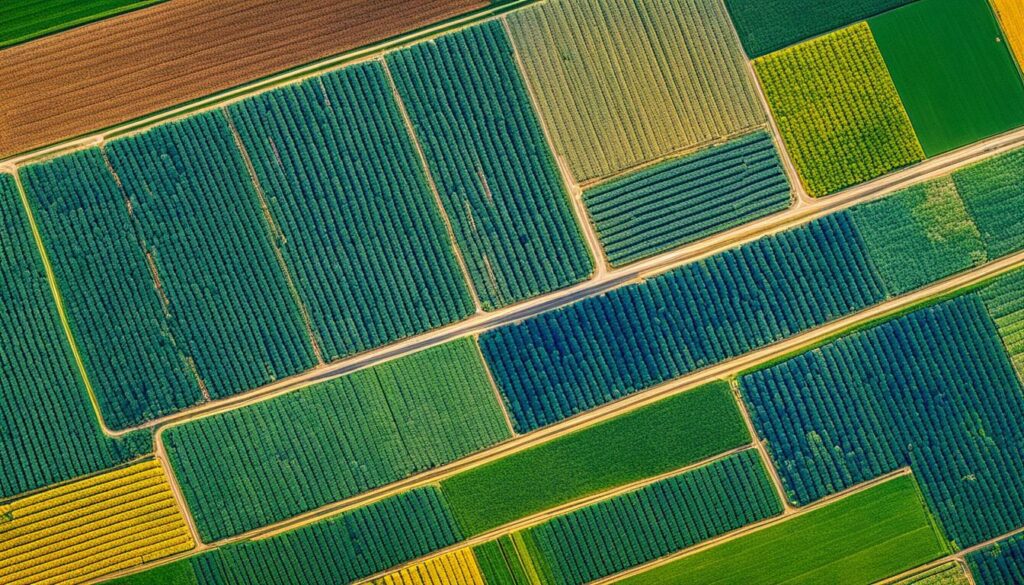
AI in crop production boosts farming through data analysis. AI predicts crop yields and warns about pests. This way, farmers can plan better, use resources well, and get more crops. It all follows the FAIR data principles.
The IoT in smart farming is a game-changer. It connects devices to share crucial data. For example, sensors check soil, weather, and crop health in real-time. IoT makes farming more efficient and eco-friendly by using resources wisely.
| Tool/Technique | Function | Benefits |
|---|---|---|
| Satellite and Drone Imagery | Data Collection | Accurate monitoring of crop health, early pest detection |
| Machine Learning and AI Algorithms | Data Analysis | Predictive modelling for crop management, optimized resource use |
| IoT in Agriculture | Interconnected Devices | Real-time data on soil conditions, efficient energy and resource management |
Through agricultural satellite imagery, AI, and IoT, farming is getting smarter. It’s not just about boosting production. These tools cut costs and make farming more sustainable. They build a strong, data-focused agriculture ready for the future.
Today, precision agriculture is transforming farming. It uses technology in agriculture to produce crops more effectively. This includes using GPS and real-time data for smarter farming.
New technology like drones and sensors makes farming more efficient. Farmers get precise information. This helps them use water, fertilisers, and crop protection better.
Variable rate fertiliser use and soil monitoring are key parts of this. They offer specific crop advice and save resources. For example, IoT devices help decide exactly how to use water and nutrients.
Drones with cameras give detailed views of fields from above. AI analyses this data. It can predict crop growth, find diseases, and offer the right time for irrigation and fertilisation.
The table below shows how precision agriculture benefits crop production:
| Technology | Function | Benefit |
|---|---|---|
| GPS | Field Mapping | Accurate Resource Placement |
| IoT Sensors | Soil Monitoring | Optimised Water Use |
| Drones | Aerial Imagery | Enhanced Disease Detection |
| AI & Machine Learning | Data Analysis | Improved Crop Predictions |
With quick decisions using lots of data, precision farming saves money. Working with AI, it gets better at predicting how much crops will yield. This pushes farming toward a sustainable and profitable future.
Advanced farming analytics are changing the game in agriculture. They help farmers use big data to make better choices. This means farmers can handle resources well, grow crops better, and spot risks early.
One key figure, Professor Claus Grøn Sørensen, says these technologies are vital. He wrote a deep, 238-page book showing how to use data for smart farming (£140.00 in hardback, ISBN-13: 9781801463829). The book is about data-driven agriculture solutions, like how to manage farm info and use tech for greener farming.
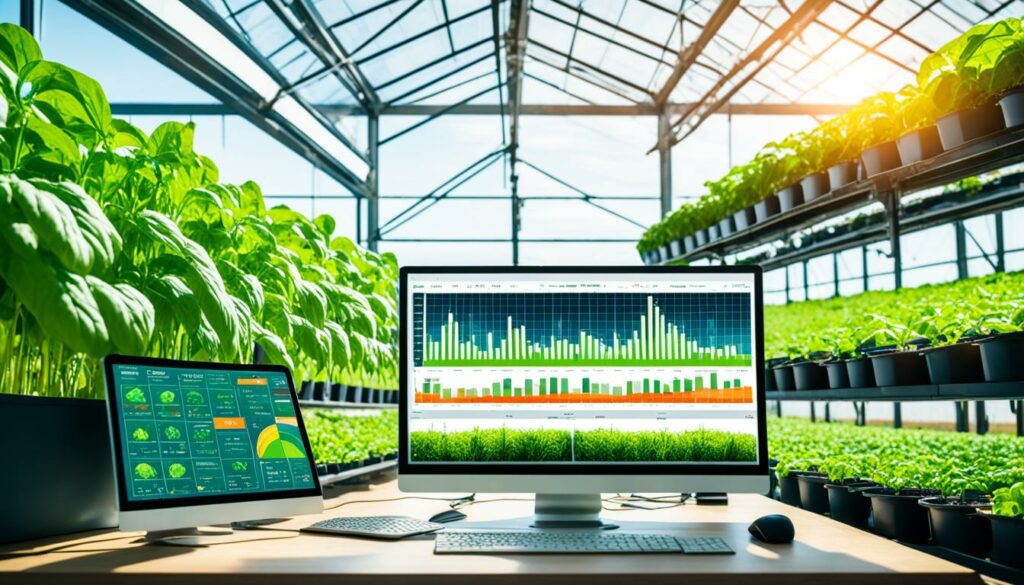
This tech makes the farming world smarter and more efficient. By using advanced analytics, farmers are finding better ways to use resources. Professor Sørensen’s insights from his book help them make these smart choices.
| Book Details | Information |
|---|---|
| Editor | Professor Claus Grøn Sørensen |
| Publication Date | 23 April 2024 |
| Length | 238 pages |
| ISBN-13 | 9781801463829 |
| Dimensions | 229x152mm |
| Price | £140.00 (Hardback) |
Data-driven farming is changing how farmers work. It uses technology like AI and smart irrigation. These tools make farming more effective and efficient.
RML AgTech shows how AI helps in farming. Their system gives farmers important info. This helps them make smarter choices about crops and resources.
Their technology lets farmers use water, fertilisers, and pesticides better. This boosts crop growth and helps the environment.
AgNext is leading in using data for crop quality. Their tools help farmers keep their crops up to high standards. This means better profits.
They use advanced maths to look at the weather. This helps plan the best times to plant and harvest.
Netafim makes top-notch irrigation systems. They water crops exactly when and how much they need. This saves water and makes crops grow better.
Their systems use data from many sources. This makes sure crops get the right amount of water and nutrients.
| Case Study | Focus Area | Key Benefits |
|---|---|---|
| RML AgTech | AI-powered analytics | Enhanced decision-making, better yields, reduced environmental impact |
| AgNext | Crop quality management | Improved produce quality, higher market standards, efficient resource use |
| Netafim | Precision irrigation | Optimised water use, increased nutrient efficiency, improved crop productivity |
These case studies show how technology is changing farming. With new tools and knowledge, farms are becoming more efficient and eco-friendly.
Data-driven farming shows a lot of promise. Yet, it faces big challenges in being adopted. For effective solutions, it’s key to know and deal with these hurdles.
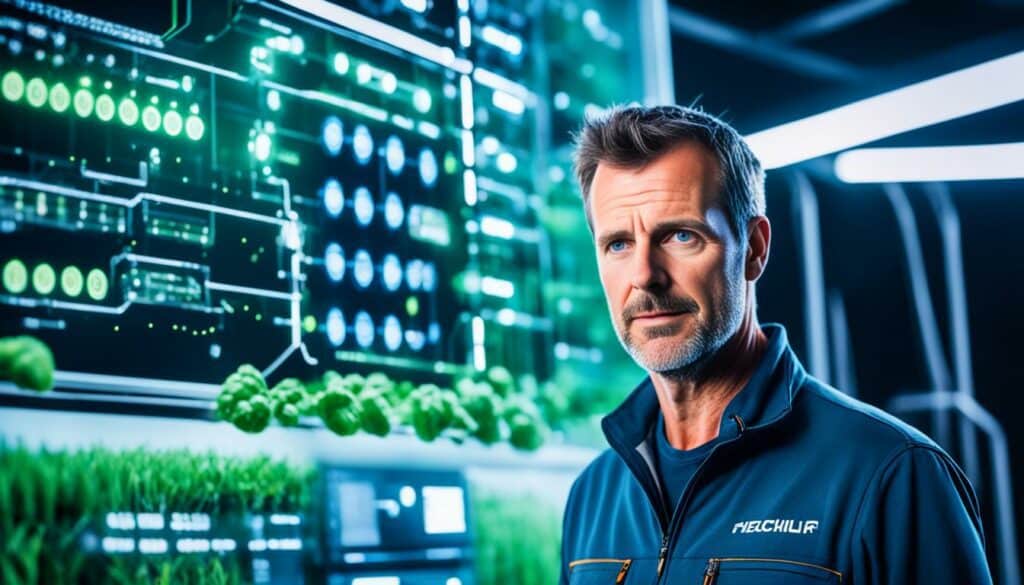
Data standardisation in farming is a major hurdle. Different tech and platforms produce lots of data. But, without set rules, merging and analysing this data is hard. Getting the data right is crucial, as wrong data can mess up choices. Getting everyone to follow the same rules is tough. This makes sharing and using data between systems a challenge.
The cost of getting advanced farming technologies is a big stopper. Even with funds like almost $200 million for precision agriculture from the USDA and NSF between 2017 to 2021, startup costs are too high for many. Also, some places lack the tech needed for these tools, which slows down their wider use. For a 70% food increase by 2050, we need everyone to get on board with these technologies.
The knowledge gap among farmers is another hurdle. Many lack the skills to run these advanced tools. So, we need to step up farming education. Farming folks should learn how to use big data and precision tools well. But, without putting in the effort on education, switching to data-driven farming won’t happen.
Dealing with these issues needs smart policies, money help, and teaching the right skills. This way, we can jump these hurdles and enjoy the benefits of technology in farming.
Dealing with data science adoption barriers in farming needs various steps. For example, poor internet access in the countryside, especially in Africa. Over 70% of people there can’t get online easily, often stuck with slow 2G or 3G speeds. This problem slows down the spread of tech in farming.
One way to fix this is for the government to improve energy and transport systems. Doing this will help move products better and make farms more efficient. Also, offering training will help farmers use new tech well.
Standardising farming data is critical for different tech to work together. Old, mixed-up data makes it hard to use new analysis or machine learning. Having a strong tech setup is key to collecting and analysing data well.
Working together with donors and research groups can speed up tech like CRISPR. This tech can create crops that give more and resist diseases. It not only boosts farming but also makes using tech in farming more common.
| Region | Annual Agriculture Growth Rate | Challenges | Strategies |
|---|---|---|---|
| Africa | 4% | Limited internet access, outdated data | Invest in infrastructure, standardise data |
| Cameroon, Ethiopia, Ghana, Mozambique | Positive productivity growth | Energy and transport issues | Government support, training initiatives |
| Senegal, Sierra Leone | Improvements in high-value crops | Variability in farm conditions | Research collaborations, tech deployment |
Defeating data science adoption barriers asks for a full plan. This includes making better infrastructure, aligning data, and working together. By tackling these issues, we can boost farming’s yield and green practices.
Big data is changing how farms work by providing farmers with important insights from loads of data. This helps them make smarter choices. These choices improve how well a farm runs, its impact on the environment, and how much money it makes.
Getting and sorting data is key to using big data in farming. Farms gather a lot of data from things like soil sensors, machines, and weather tools. Precision farming data management systems sort and use this data better. This helps farms waste fewer resources, saving money.
Real-time data use in agriculture lets farmers make quick and smart choices. These choices can boost crop yields by up to 25% by advising on water, fertiliser, and fighting pests. Watching the health of crops as they grow can cut losses by 20%. It makes sure help comes at the right time.
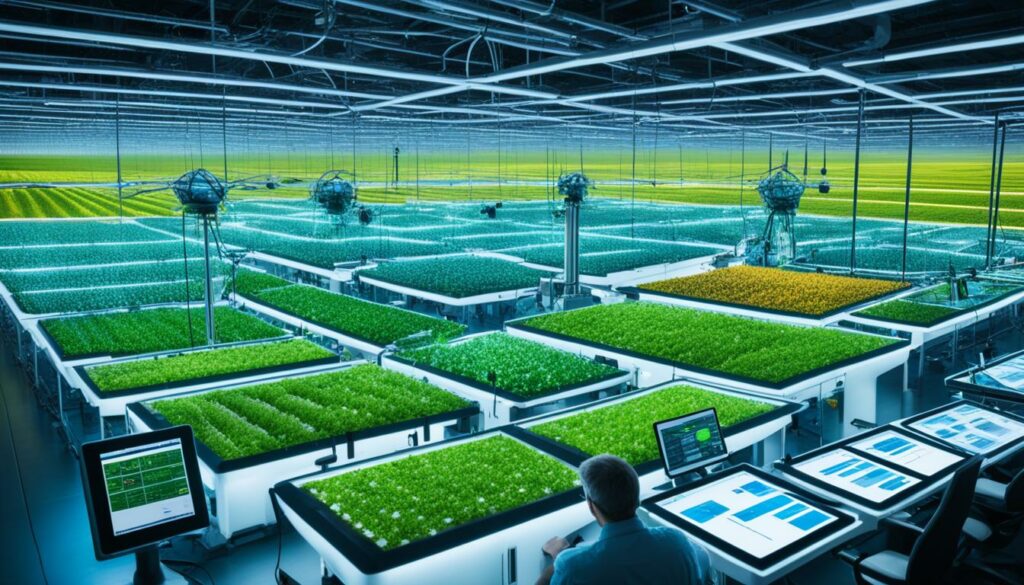
Using big data can increase how much farms produce and earn. It makes managing supplies better, boosting farm efficiency by 30%. Also, smart farming with big data can save up to 15% on costs. This means more crops and money for farmers.
Big data also helps farmers deal with bad weather, pests, and market changes. With data tools, farmers can plan smarter. This makes their farms stronger and more able to face tough times.
By 2050, our world will likely have 9.7 billion people. To feed everyone, farming must produce 70% more food. Automated farming processes are key. They boost farming efficiency and reduce the need for people to work the fields. This helps cut down on a big cost for farms. In fact, over 50% of a farm’s costs are because of manual work.
Mechanisation in agriculture goes beyond turning farm tasks into factory jobs. It uses robots, digital tools, and self-operating systems to do jobs more accurately. For example, a robot that picks strawberries can do the work of 30 people. It can handle a 25-acre field in just three days. This kind of smart tech greatly lowers the money spent on workers and means fewer people are needed to run the farm.
Automating farming tasks also helps the environment. When it comes to weeding, using machines cuts down on the need for pesticides by 90%. This is a big win for the planet. Plus, using AI and real-time data for farming allows for the precise use of chemicals. This reduces waste and harm to the Earth.
The value of smart farming is set to soar from $5.5 billion in 2019 to $12.8 billion by 2026. This kind of tech is essential for the future of farming. It lets us grow better crops while using fewer resources. It’s true that at the beginning, the costs are high, especially for countries that are still growing. But the long-term benefits in more food, saving money, and protecting the planet are worth it.
| Impact Area | Labour Reduction | Environmental Footprint | Economic Value |
|---|---|---|---|
| Strawberry Robot Harvester | Replaces 30 Farm Workers | — | — |
| Automated Weeding | — | 90% Reduction in Pesticide Usage | — |
| Precision Farming Market Growth | — | — | $5.5B in 2019 to $12.8B by 2026 |
By 2050, more food will be needed as the population grows. This means we must find new ways to grow food. Agricultural technology trends are looking into ways to do this. One method being tested is indoor vertical farming. It uses much less water than usual, which also helps in cities where space is limited.
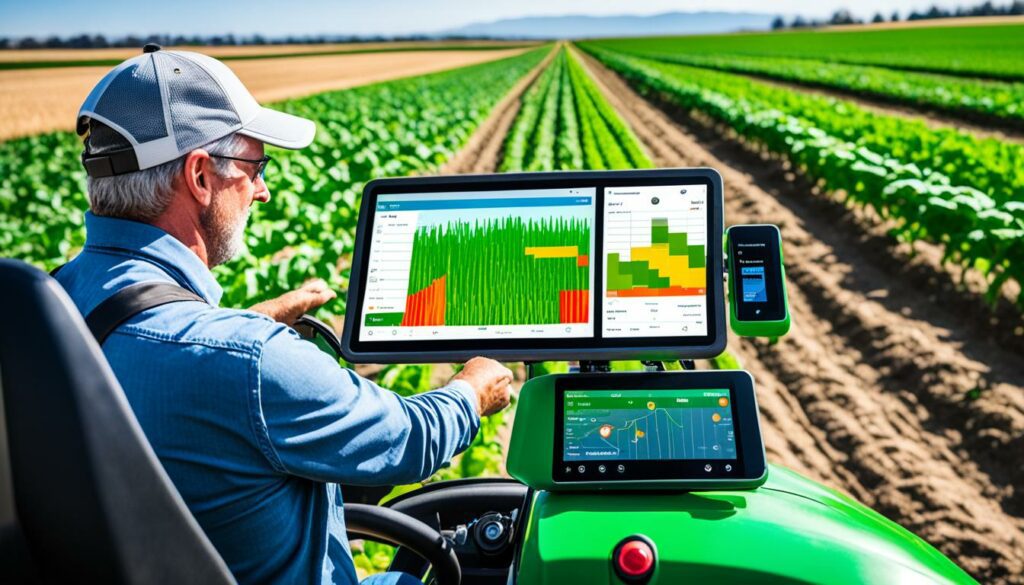
Minichromosome technology is also making waves in farming. It allows us to improve plants without changing their genes directly. This could mean using less pesticides and fertilisers. It’s a step towards farming that is more kind to the environment.
Precision farming is getting a lot of attention too. It’s expected to be a $16.35 billion market by 2028. This approach uses data to grow crops more efficiently. It aims to have a lesser impact on the planet. The use of farm management software is also increasing rapidly. By 2026, it’s estimated to grow at a rate of 11.2%. This shows how farming is becoming more digital.
The global greenhouse market is huge, providing about $350 billion worth of vegetables each year. With new technologies, including future agricultural innovations, we aim to make farming more stable and efficient.
| Agricultural Technology | Benefits | Projected Growth |
|---|---|---|
| Indoor Vertical Farming | 70% less water usage | $16.35 billion by 2028 (13.1% CAGR) |
| Minichromosome Technology | Reduces pesticide and fertiliser use | Continues to expand as an eco-friendly solution |
| Farm Management Software | Optimises crop management | 11.2% CAGR until 2026 |
| Greenhouse Farming | $350 billion in annual vegetable production | Rapidly increasing market share |
In today’s farming, robotics and AI are making big changes. They boost efficiency and productivity a lot. This leads to better crops and a smarter way to use resources.
AI helps in many ways in agriculture. It includes high-tech tools to track pests and diseases. This reduces crop losses to pests, which can be as high as 40%. Also, AI tech can track livestock health, signalling issues early.
There are many kinds of farm robots doing different jobs. Some place stakes in soil, while others help farmers communicate with their equipment. These robots are getting more common, improving how farms work.
Buying AI and robots for farming can be costly at first. But, it pays off in the long run. Tools powered by AI can save up to 95% of water on farms. This saves money and is good for the planet. Improved tech also means less need for workers, saving more money over time.
| Metrics | Traditional Farming | Smart Farming with AI and Robotics |
|---|---|---|
| Water Usage | High | 95% Less |
| Labour Costs | High | Significantly Lower |
| Crop Losses due to Pests | Up to 40% | Drastically Reduced |
| Crop Yield | Averages | Optimised |
Getting into data-driven farming means understanding the big impact of farm data. It covers things like what crops are grown, how healthy the animals are, if machines work well, and how safe the work is. Paying attention to these records can change how farms are run. Approaches like precision farming show that watching data closely helps find the best crop pattern. This can boost how much is grown, and cut down on harmful chemicals.
What should farms do to be smart with their data? They should use online storage services like Dropbox or Google Drive. This makes it easy to save and find important data. With the right info at hand, they can make smarter choices about when to plant or harvest. This not only helps the farm work better but also makes farming kinder to the planet.
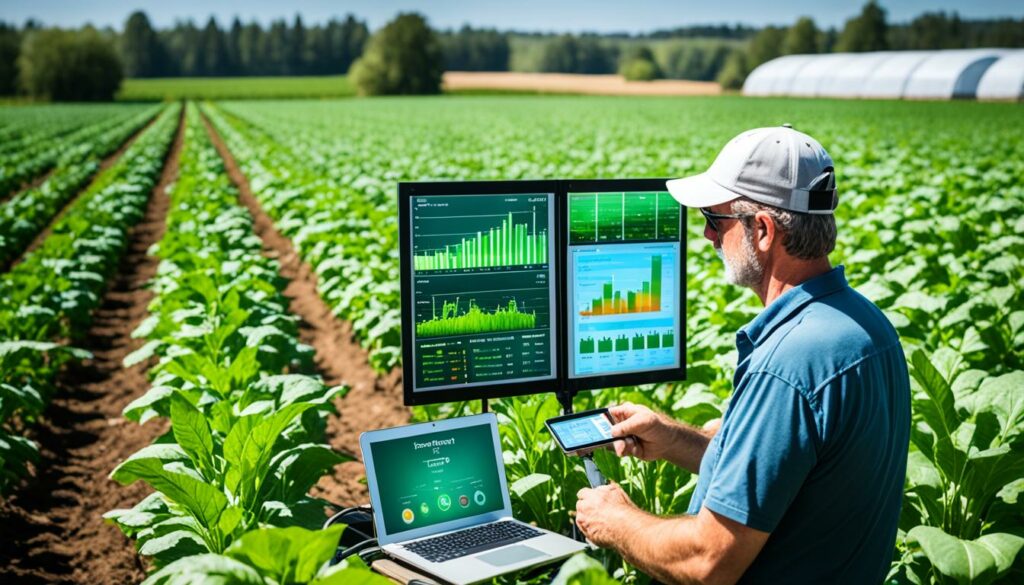
Using data smartly makes it easier to make good choices. For example, a farmer who looked at weather and ground moisture could use less water without hurting crops. These smart ways of using data can make farming both better and cheaper.
“Fuel efficiency tracking of tractors, for example, reveals potential cost-saving opportunities through better maintenance or timely upgrades.”
It’s also super important to keep looking at the farm data and turning it into useful tips. This helps farms get ready for problems before they happen. Having someone like a farming coach, such as at Enable Ag, can make a big difference. They bring know-how and special tools to make the farm more efficient, giving farmers more time to themselves.
| Key Metrics | Benefits |
|---|---|
| Soil Health Data | Optimal crop rotation, reduced chemical use |
| Fuel Efficiency | Cost-saving through maintenance and upgrades |
| Irrigation Schedules | Reduced water usage while maintaining yield |
| Historical Weather Data | Enhanced resource allocation and productivity |
In the end, using these tips and tools can really make farming better. They are all about using technology to farm smarter and cleaner. This way, farming doesn’t just get more efficient. It also helps farmers look ahead and care more for the environment.
Data-driven farming is set to change agriculture in the future. This new way of farming uses technology to revolutionise farm practices. It tackles the challenges of climate change, a growing population, and the need for more food. Farmers can use this approach to use resources better, cut down on waste, and help the environment.
By using data and high-tech tools, farmers get key details to look after their crops. They can predict how much their crops will yield and spot dangers like pests and diseases early. This boosts their output and improves the quality of the food they grow. Also, with smart farming tools, they can keep a close eye on soil and plant health.
Thanks to satellite and drone data and the progress in robots and AI, farming is changing fast. Now, farmers can water their crops exactly where needed, use tailored technology to farm smarter, and cut the need for hard manual work. This leads to farms working better and costing less to run. As we face this exciting change, the future of data-driven farming looks bright. It aims to make farming greener, more secure in producing food, and friendly to the planet.
Data-driven farming uses data analytics, tech, and learning machines. It helps in improving parts of farming like managing water and soil. It also looks into tracking crops and how resources are used.
Climate change affects farming by changing weather, causing extreme events, and might lower crop yields. In response, farmers need new ways to manage resources and adapt crops to these changes.
Smart farming needs tools like satellite and drone imagery, IoT devices, machine learning, and sensors. These technologies collect and analyse data. This helps in making smart choices about crop health, water use, and soil.
Precision agriculture boosts crop yields while lowering environmental impact. It uses GPS tech, real-time data, and tailored systems for crops. This way, it optimises how resources are used.
Data science enhances soil by looking at detailed soil data, spotting issues, and recommending actions. It can help with things like better fertilisation and watering.
Examples are RML AgTech’s AI for small farmers, AgNext’s crop quality tools, and Netafim’s irrigation systems. These technologies boost crop health, save resources, and make farming more profitable.
Big data is key in farming as it gathers and analyses a lot of farming info. This helps farmers make smarter choices, improve how they work, and raise productivity in many areas.
The main hurdles are making data match up, tech costs, and educating farmers. Solving these issues needs investment, training, and ensuring tech can work well on different platforms.
Automation in farming means using robots, digital tech, and systems that do tasks on their own. It improves precision, cuts down on manual work, and makes farming more efficient.
The future includes more robotics, AI, and big data used to tackle tough farming issues. These advancements aim to make farming more efficient and resilient.
Farmers use robotics and AI for jobs like harvesting and fighting diseases, plus AI for planning and working more efficiently. Though costly at first, the savings on work and money in the long run are worth it.